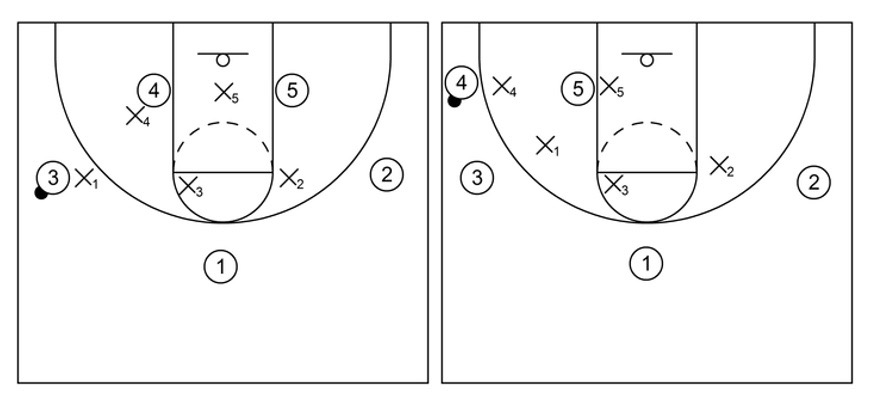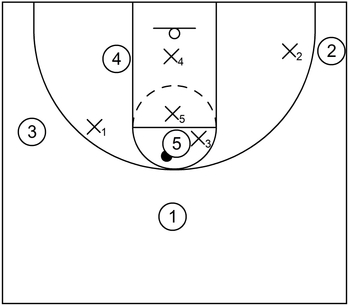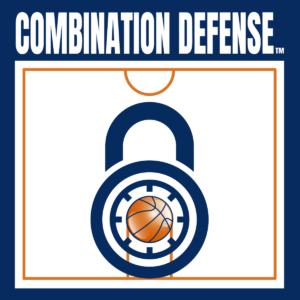The Box and 1 Defense stands out as possibly the most well-known “junk” defenses available to basketball coaches. This defensive strategy tries to limit the scoring opportunities of your opponent’s best player. This is accomplished by installing a combination defense that relies on both man-to-man and zone principles.
A Box and 1 takes your team’s best defender and task him with disrupting the playmaking opportunities of your opponent’s top perimeter scorer. At the same time, the additional four defenders will play a zone in the form of a box, hence “box and 1.” This defense requires excellent athleticism and anticipation on the part of the single defender, while emphasizing communication and rotation for the box players.
This defense stands built around the chaser’s ability to hound an opponent. The zone defenders cover the perimeter areas adjacent to their respective side of the floor or implement weak side defensive principles.
Pros and Cons of the Box and 1
The Box and 1 defense can be a polarizing topic among coaches. And, like other defensive schemes, this approach comes with advantages and disadvantages.
The most obvious pro to this defensive approach is trying to neutralize, or at least render inefficient, your opponent’s top offensive player. This remains particularly effective against teams whose offense is predicated around one player scoring the majority of points. The ball-denial aspect of this defensive approach often short-circuits an offensive possession, something that comes in handy in games using shot clocks or in end-of-game situations.
Another pro to using a box and 1 is it’s also very effective against squads with below average perimeter shooting abilities.
One significant con of this defensive strategy arises when your team’s best perimeter defender is also your team’s best offensive player. The chaser’s defensive responsibilities eat up his energy, which limits his offensive effectiveness. This approach leads to fatigue for the chaser, so ideally, this player isn’t your top scorer as well.
Perhaps the biggest con of installing a box and 1 defense comes from the formation itself. The middle of the floor often opens wide for the opposing offense, especially in ball reversal situations. One clear point of weakness is the high-post area. If the offensive team is able to get the ball into the high post, then the box and 1 becomes vulnerable to offensive tactics such as corner skip passes or high low action near the basket.
Other cons with this defense include isolating post defenders from help and creating potentially easier scoring opportunities for secondary playmakers.
Basic Rotations in a Box and 1 Defense
The basic formation of the box and 1 defense features the “chaser” matched up on the perimeter while the other defensive players set up the box on defense. This initial set up covers the elbows and well as both low blocks. Depending upon the initial offensive actions, the defense must communicate and rotate to cover.
The graphic below shows X2 as the “chaser” defender, matched up with offensive Player 2.

The initial offensive action in the figure above results in a pass to the wing. The box defenders prevented a dribble drive and forced that first pass. X1 follows the pass on the first rotation, while X3 rotates to the high-post or “nail” defensive position. X4 fronts a low post pass while X5 slides into the lane. X2 can shift into help-side position, but with the box and 1 defense, ball denial remains his main focus.
A pass to the corner involves additional defensive rotation. X4 applies ball pressure, while X1 slides to help side. X3 remains covering the nail and X5 covers any low post cuts. X2 remains tethered to Player 2.
Points of emphasis for these defensive rotations include: quick closeouts and communication. Defenders need to contest open jump shots, as well as prevent dribble drives.
 If the offense gets the ball into the high-post area, the box and 1 becomes vulnerable to breaking down. The defense needs to adjust its rotations accordingly.
If the offense gets the ball into the high-post area, the box and 1 becomes vulnerable to breaking down. The defense needs to adjust its rotations accordingly.
The primary method of mitigating that is to have one of the bottom zone defenders sprint up the lane to quickly cover the player with the ball. For this case, X5 covers 5 while X4 stays back to protect the basket.
In addition, one or both of the top zone defenders can help double team or triple team the ball to encourage the high post player to pass it to the perimeter.
The chaser, which is X2, shouldn’t sag off the target because the ball is in the high post. In other words, if X2 were to sag off, then Player 2 could easily receive the ball from 5 such as with a corner skip.
Players must communicate in this defensive setup. If they don’t, they will fail. Forcing players to talk and think on their feet as they scramble is making practice harder than what they will likely face in a game situation. Defenders must be aware of the ball handler. The ultimate goal is to stop the offense from scoring, so help defense must be alert and stop the ball when necessary.
Variations of the Box and 1 Defense include: the Triangle and 2 as well as the Diamond and 1.
Learn the Combination Defense to beat the BEST team on your Schedule!
Go to COMBINATIONDEFENSE.com now for all your coaching needs.
This innovation defensive coaching lesson includes everything a coach needs to implement these game-changing strategies.
Among the combo defenses dissected in this lesson are the Box and 1, the Triangle and 2, the Diamond and 1.
Content includes:
- Engaging Video Lessons
- Drills and Implementation Practices
- Q & A
- Bonus sections features – Offenses vs Combo Defenses, Tracking and Possession Charts
Related: 3 Great Defensive Drills to Improve Help and Rotation
Resources:
The Coach Unplugged Podcast

Ep 1406 Office Hours and Combination Defenses
If you found this useful, don’t forget to check out additional blog posts at TeachHoops.com. Also, check out TeachHoops on Facebook, Twitter, Instagram and YouTube.



